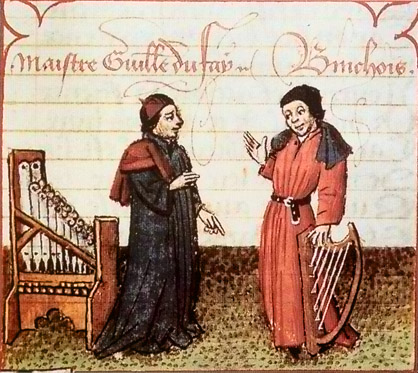
Burgundian School
The Burgundian School was a group of composers active in the 15th century in what is now northern and eastern France, Belgium, and the Netherlands, centered on the court of the Dukes of Burgundy. The school inaugurated the music of Burgundy.
The main names associated with this school are Guillaume Dufay, Gilles Binchois, Antoine Busnois and (as an influence), the English composer John Dunstaple. The Burgundian School was the first phase of activity of the Franco-Flemish School, the central musical practice of the Renaissance in Europe.
Background[edit]
In late Medieval and early Renaissance Europe, cultural centers tended to move from one place to another due to changing political stability and the presence of either the spiritual or temporal power, for instance the Pope, Anti-pope or the Holy Roman Emperor. In the 14th century, the main centers of musical activity were northern France, Avignon, and Italy, as represented by Guillaume de Machaut and the ars nova, the ars subtilior, and Landini respectively; Avignon had a brief but important cultural flowering because it was the location of the Papacy during the Western Schism. When France was ravaged by the Hundred Years' War (1337–1453), the cultural center migrated farther east, to towns in Burgundy and the Low Countries, known then collectively as the Netherlands.[1]
During the reign of the House of Valois, Burgundy was the most powerful and stable political division in western Europe, and added, a bit at a time, Flanders, Brabant, Holland, Luxembourg, Alsace and Lorraine. Especially during the reigns of Philip the Good (1419–1467) and Charles the Bold (1467–1477), this entire area, loosely known as Burgundy, was a center of musical creativity. Most of the musical activity did not take place in what is modern-day Burgundy, which has its capital in Dijon (even though the Dukes of Burgundy maintained an administrative center there). The main centers of music-making were Brussels, Bruges, Lille, and Arras, as well as smaller towns in that same general area.[1]
Musicians from the region came to Burgundy to study and further their own careers as the reputation of the area spread. The Burgundian rulers were not merely patrons of the arts, but took an active part: Charles the Bold himself played the harp, and composed chansons and motets (although none have survived with reliable attribution). The worldly dukes also encouraged the composition of secular music to a degree seen only rarely before in European music history, a characteristic which itself defines the Burgundian epoch as a Renaissance phenomenon.[2]
This migration of musical culture east from Paris to Burgundy also corresponds with the conventional (and by no means universally accepted) division of music history into Medieval and Renaissance; while Guillaume de Machaut is often considered to be one of the last Medieval composers, Dufay is often considered to be the first significant Renaissance composer.
Charles the Bold was killed in 1477 in the Battle of Nancy, during one of his attempts to add territory to his empire. After his death, music continued to flourish as before, but the region was split politically, with the duchy of Burgundy being absorbed into France, and most of the Low Countries becoming part of the holdings of the Spanish Habsburgs. Both the French court and the Habsburgs were patrons of music; however, a French style began to diverge from that of the Low Countries, especially in secular music, and in the period after 1500.
Composers[edit]
The history of Burgundian music began with the organization of the chapel in 1384; twenty years later, it rivaled the famous establishment at Avignon in splendor. Names associated with this early phase of Burgundian music include Johannes Tapissier and Nicolas Grenon, who carried the tradition across to the next phase of the chapel, when it was reorganized in 1415. Other early composers there were Hugo and Arnold de Lantins, both of whom Dufay later met in Italy.
Of all the names associated with the Burgundian School, the most famous was Guillaume Dufay, who was probably the most famous composer in Europe in the 15th century. He wrote music in many of the forms which were current, music which was melodic, singable and memorable (more than half of his sacred music consists of simple harmonizations of plainsong, for example). Contemporary with Dufay were composers such as Gilles Binchois, who was at the Burgundian court between approximately 1430 and 1460, and Hayne van Ghizeghem, a composer, singer and soldier who may have been killed in the last military campaign of Charles the Bold.
After the death of Dufay in 1474, the most prominent Burgundian musician was Antoine Busnois, who was also a prolific composer of chansons, and who possibly wrote the famous L'homme armé tune.
There are approximately 65 manuscript sources which contain music by Burgundian composers. The most prominent of these include: